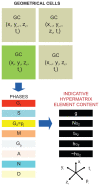Introduction of hypermatrix and operator notation into a discrete mathematics simulation model of malignant tumour response to therapeutic schemes in vivo. Some operator properties
- PMID: 20011462
- PMCID: PMC2791491
- DOI: 10.4137/cin.s2712
Introduction of hypermatrix and operator notation into a discrete mathematics simulation model of malignant tumour response to therapeutic schemes in vivo. Some operator properties
Abstract
The tremendous rate of accumulation of experimental and clinical knowledge pertaining to cancer dictates the development of a theoretical framework for the meaningful integration of such knowledge at all levels of biocomplexity. In this context our research group has developed and partly validated a number of spatiotemporal simulation models of in vivo tumour growth and in particular tumour response to several therapeutic schemes. Most of the modeling modules have been based on discrete mathematics and therefore have been formulated in terms of rather complex algorithms (e.g. in pseudocode and actual computer code). However, such lengthy algorithmic descriptions, although sufficient from the mathematical point of view, may render it difficult for an interested reader to readily identify the sequence of the very basic simulation operations that lie at the heart of the entire model. In order to both alleviate this problem and at the same time provide a bridge to symbolic mathematics, we propose the introduction of the notion of hypermatrix in conjunction with that of a discrete operator into the already developed models. Using a radiotherapy response simulation example we demonstrate how the entire model can be considered as the sequential application of a number of discrete operators to a hypermatrix corresponding to the dynamics of the anatomic area of interest. Subsequently, we investigate the operators' commutativity and outline the "summarize and jump" strategy aiming at efficiently and realistically address multilevel biological problems such as cancer. In order to clarify the actual effect of the composite discrete operator we present further simulation results which are in agreement with the outcome of the clinical study RTOG 83-02, thus strengthening the reliability of the model developed.
Keywords: cancer multiscale modeling; computer models; hypermatrix; in silico oncology; oncosimulator; operator notation; radiobiology; tumour growth; tumour response to treatment.
Figures





Similar articles
-
The technologically integrated oncosimulator: combining multiscale cancer modeling with information technology in the in silico oncology context.IEEE J Biomed Health Inform. 2014 May;18(3):840-54. doi: 10.1109/JBHI.2013.2284276. Epub 2013 Oct 2. IEEE J Biomed Health Inform. 2014. PMID: 24108720
-
The "Oncosimulator": a multilevel, clinically oriented simulation system of tumor growth and organism response to therapeutic schemes. Towards the clinical evaluation of in silico oncology.Annu Int Conf IEEE Eng Med Biol Soc. 2007;2007:6629-32. doi: 10.1109/IEMBS.2007.4353879. Annu Int Conf IEEE Eng Med Biol Soc. 2007. PMID: 18003545
-
In silico oncology: exploiting clinical studies to clinically adapt and validate multiscale oncosimulators.Annu Int Conf IEEE Eng Med Biol Soc. 2013;2013:5545-9. doi: 10.1109/EMBC.2013.6610806. Annu Int Conf IEEE Eng Med Biol Soc. 2013. PMID: 24110993
-
'In silico' oncology for clinical decision making in the context of nephroblastoma.Klin Padiatr. 2009 May-Jun;221(3):141-9. doi: 10.1055/s-0029-1216368. Epub 2009 May 12. Klin Padiatr. 2009. PMID: 19437361 Review.
-
The role of pattern recognition in creative problem solving: a case study in search of new mathematics for biology.Prog Biophys Mol Biol. 2013 Sep;113(1):181-215. doi: 10.1016/j.pbiomolbio.2013.03.017. Epub 2013 Apr 15. Prog Biophys Mol Biol. 2013. PMID: 23597605 Review.
Cited by
-
Clinically driven design of multi-scale cancer models: the ContraCancrum project paradigm.Interface Focus. 2011 Jun 6;1(3):450-61. doi: 10.1098/rsfs.2010.0037. Epub 2011 Mar 30. Interface Focus. 2011. PMID: 22670213 Free PMC article.
-
Model-Supported Radiotherapy Personalization: In silico Test of Hyper- and Hypo-Fractionation Effects.Front Physiol. 2018 Oct 15;9:1445. doi: 10.3389/fphys.2018.01445. eCollection 2018. Front Physiol. 2018. PMID: 30374310 Free PMC article.
-
Integrating Multiscale Modeling with Drug Effects for Cancer Treatment.Cancer Inform. 2016 Jan 13;14(Suppl 5):21-31. doi: 10.4137/CIN.S30797. eCollection 2015. Cancer Inform. 2016. PMID: 26792977 Free PMC article. Review.
References
-
- Kansal AR, Torquato S, Harsh GR, Chiocca EA, Deisboeck TS. Simulated brain tumour growth dynamics using a three‐dimensional cellular automaton. J Theor Biol. 2000a;203:367–82. - PubMed
-
- Kansal AR, Torquato S, Harsh IV, Chiocca EA, Deisboeck TS. Cellular automaton of idealized brain tumour growth dynamics. BioSystems. 2000b;55:119–27. - PubMed
-
- Kraus M, Wolf B. Emergence of self‐organization in tumour cells: relevance for diagnosis and therapy. Tumour Biol. 1993;14:338–53. - PubMed
-
- Jones B, Dale RG. Mathematical models of tumour and normal tissue response. Acta Oncol. 1999;38:883–93. - PubMed
-
- Duechting W, Ginsberg T, Ulmer W. Modelling of radiogenic responses induced by fractionated irradiation in malignant and normal tissue. Stem Cells. 1995;13(S1):301–6. - PubMed
LinkOut - more resources
Full Text Sources

